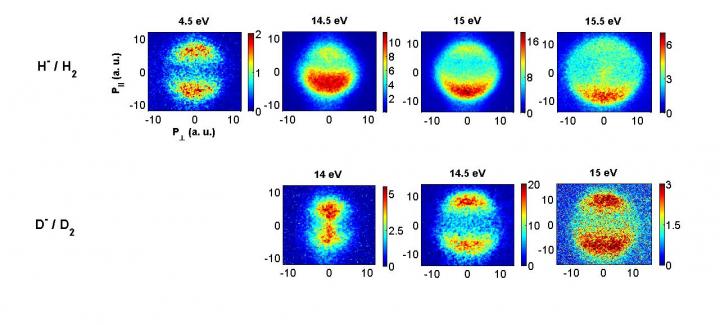Creation of coherent states in molecules by incoherent electrons

Momentum images of H from H2 and D from D2 at different electron energies. The one at 4 eV for H is symmetric, while those above 14 eV are strongly asymmetric. The asymmetry in D is less pronounced and appear to change direction with change in electron energy. Credit: E. Krishnakumar et al, Nature Physics
Their latest results published in the Journal, Nature Physics (DOI: 10.1038/nphys4289), show that the coherence induced by the capture of single electron by H2 molecule results in the ejection of H? ion in preferentially backward direction with respect to the incoming electron beam.
The other product of the dissociation is the H-atom in its excited state. In other words, this coherence induced in the molecule segregates the charge and excess energy in the system in a preferred manner. Similar measurements in the isotopomer of H2 namely D2 does not show such a strong asymmetry in ejection of the fragment ion but shows the reversal of the asymmetry as a function of incoming electron energy.
So far researchers have used such coherence induced by laser beams to control molecular dissociation and have considered it as the basis for possible control of chemical reactions using photons. But in that case, the coherence in the resulting excited molecular entity is understood to stem from the absorbed laser radiation. By demonstrating the presence of such coherence resulting from a capture of an incoherent electron, Prof. Krishnakumar and co-workers have shown that such coherence can also stem from the transfer of more than one value of angular momentum quanta.
On the capture of a low energy electron, a relatively unstable molecular negative ion is formed. Subsequently, this negative ion decays by ejecting the extra electron. However, if the ion survives against the electron ejection, it undergoes dissociation.
This is known as dissociative attachment. According to Prof. Krishnakumar, dissociative attachment is traditionally linked with transfer of multiple values of angular momentum quanta in the molecular system. However, it is for the first time such a quantum coherent response has been observed from a molecule.
Low energy electrons are ubiquitous and are known to play important role in variety of phenomena relevant to astrochemistry (where they participate in synthesis of new molecules), in radiation biology (where they cause chemical changes in living cell, plasma chemistry), atmospheric chemistry, radioactive waste management and nanolithography — to name but a few.
In all these cases, dissociative attachment plays a critical role. The unstable excited molecular negative ion states are at the core of this process. However, due to very short lifetime of these species very little is known about them at present.
The group led by Prof. Krishnakumar and Dr. Prabhudesai in TIFR has pioneered research on several aspects of low energy electron interactions with molecules in gas and condensed phase with particular emphasis on the possibility of controlling chemical reactions using low energy electrons.
These new results point to rich unexplored dynamics of excited molecular negative ions that might open up new possibilities in inducing chemical control. They also pose a challenge to theoreticians to come up with a detailed model for the negative ion chemistry that is associated with low energy free electron scattering.
These measurements were carried out by Prof. Krishnakumar using an experiment built by him at the Open University in UK, where he was on invitation as a Marie Curie Professor to help build a novel electron scattering experiment for the European scientists, similar to the one he had conceived and built at TIFR. Dr. Prabhudesai and Prof. Krishnakumar provided the interpretation of the data along with the model.
Media Contact
All latest news from the category: Physics and Astronomy
This area deals with the fundamental laws and building blocks of nature and how they interact, the properties and the behavior of matter, and research into space and time and their structures.
innovations-report provides in-depth reports and articles on subjects such as astrophysics, laser technologies, nuclear, quantum, particle and solid-state physics, nanotechnologies, planetary research and findings (Mars, Venus) and developments related to the Hubble Telescope.
Newest articles

High-energy-density aqueous battery based on halogen multi-electron transfer
Traditional non-aqueous lithium-ion batteries have a high energy density, but their safety is compromised due to the flammable organic electrolytes they utilize. Aqueous batteries use water as the solvent for…

First-ever combined heart pump and pig kidney transplant
…gives new hope to patient with terminal illness. Surgeons at NYU Langone Health performed the first-ever combined mechanical heart pump and gene-edited pig kidney transplant surgery in a 54-year-old woman…

Biophysics: Testing how well biomarkers work
LMU researchers have developed a method to determine how reliably target proteins can be labeled using super-resolution fluorescence microscopy. Modern microscopy techniques make it possible to examine the inner workings…





















